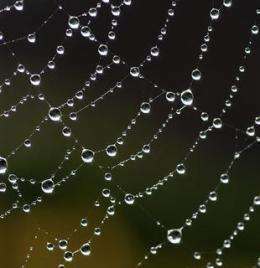Nanomaterials help spiders spin the toughest stuff

Spiders' silk is already tough stuff—just ask your friendly neighbourhood Spiderman.
But now, researchers in Italy and the UK have found a way to make Spidey's silk a lot stronger, using various different spider species and carbon nanotubes or graphene.
The research team, led by Professor Nicola Pugno at the University of Trento, Italy, succeeded in having their spiders produce silk with up to three times the strength and ten times the toughness of the regular material.
Their discovery, published today in the journal 2D Materials, could pave the way for a new class of bionicomposites, with a wide variety of uses.
Professor Pugno said: "Humans have used silkworm silks widely for thousands of years, but recently research has focussed on spider silk, as it has extremely promising mechanical properties. It is among the best spun polymer fibres in terms of tensile strength, ultimate strain, and especially toughness, even when compared to synthetic fibres such as Kevlar."
"We already know that there are biominerals present in in the protein matrices and hard tissues of insects, which gives them high strength and hardness in their jaws, mandibles and teeth, for example. So our study looked at whether spider silk's properties could be 'enhanced' by artificially incorporating various different nanomaterials into the silk's biological protein structures."
To do this, the team exposed three different spider species to water dispersions containing carbon nanotubes or graphene.
After collecting the spiders' silk, the team tested its tensile strength and toughness.
Professor Pugno said: "We found that the strongest silk the spiders spun had a fracture strength up to 5.4 gigapascals (GPa), and a toughness modulus up to 1,570 joules per gram (J/g). Normal spider silk, by comparison, has a fracture strength of around 1.5 GPa and a toughness modulus of around 150 J/g."
"This is the highest fibre toughness discovered to date, and a strength comparable to that of the strongest carbon fibres or limpet teeth. These are still early days, but our results are a proof of concept that paves the way to exploiting the naturally efficient spider spinning process to produce reinforced bionic silk fibres, thus further improving one of the most promising strong materials." "These silks' high toughness and resistance to ultimate strain could have applications such as parachutes". "Furthermore, this process of the natural integration of reinforcements in biological structural materials could also be applied to other animals and
More information: Emiliano Lepore et al, Spider silk reinforced by graphene or carbon nanotubes, 2D Materials (2017). DOI: 10.1088/2053-1583/aa7cd3
Provided by Institute of Physics



















